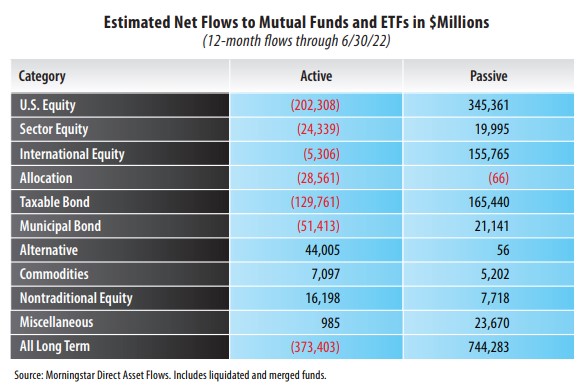
View from the Observation Deck
1. Investors directing capital into mutual funds and exchange traded funds (ETFs) continued to favor passive investing over active management on a massive scale for the 12-month period ended 6/30/22. This has been the case for the past several years.
2. Passive mutual funds and ETFs reported estimated net inflows totaling $744.28 billion for the period captured in the table above, down from $765.48 billion at this point a year ago. Active funds reported estimated net outflows totaling $373.40 billion, up from $280.67 billion in outflows at this point a year ago.
3. The largest amount of total net inflows (active + passive) in the period belonged to the International Equity, U.S. Equity, Alternative and Taxable Bond categories at $150.46 billion, $143.05 billion, $44.06 billion and $35.68 billion, respectively.
4. The active categories garnering the most interest from investors by far over the past 12 months via net inflows were Alternative, Nontraditional Equity and Commodities.
5. Despite the declines in the major global stock indices for the 12-month period ended 6/30/22, investors funneled more capital into equities than any other category.
6. The S&P 500, S&P MidCap 400 and S&P SmallCap 600 Indices posted total returns of -10.62%, -14.64% and -16.81% respectively, for the 12-month period ended 6/30/22, according to Bloomberg. With respect to foreign equities, the MSCI Daily TR Net World (ex U.S.) and MSCI Emerging Net TR Indices posted total returns of -16.76% and -25.28%, respectively.
7. The U.S. Dollar Index (DXY) rose by 13.25% for the 12-month period ended 6/30/22, according to Bloomberg. The index reflects the general international value of the dollar relative to a basket of major world currencies. The index being up that much means the dollar provided significant drag on the performance of unhedged foreign securities held by U.S. investors, in our opinion.



